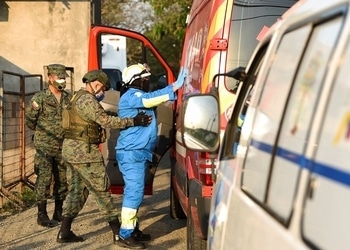After yet another prison massacre, Ecuadorean authorities have doubled down on Mexico’s two biggest cartels being behind gang warfare in the South American nation by providing weapons and cash to their chosen partners.
On November 12 and 13, riots at the Litoral prison in the southern port city of Guayaquil left at least 68 inmates dead and 25 more injured. This was the third large-scale massacre in Ecuador this year, with prison violence having killed over 320 people in 2021 alone, mainly at Litoral.
The wave of violence has been sparked by a civil war among the Choneros – once Ecuador’s largest gang and a trusted transporter of cocaine shipments for Colombian and Mexican groups – and several rivals, including the Lobos, Tiguerones, Chone Killers and Lagartos.
SEE ALSO: Profile of the Choneros
For the government, the conflict has been worsened by the involvement of Mexico’s Sinaloa Cartel, backing the Choneros, and the Jalisco Cartel New Generation (Cartel Jalisco Nueva Generación – CJNG), supporting its rivals.
“We are no longer facing common delinquents but the largest drug cartels in the entire world,” said President Guillermo Lasso in an address to the nation on November 15, adding that “Ecuador finds itself under a severe external attack by drug trafficking mafias.”
For Mario Pazmiño, Ecuador’s former head of intelligence, the culprits are clear. “Violence spiked when local criminal gangs started working for the rival Mexican Sinaloa and Jalisco New Generation drug cartels,” he told The Guardian.
“The level of corruption is so high that the prison staff and officers are totally corrupted and the prisoners run the jail,” he added.
InSight Crime Analysis
The actual scale of the involvement of Mexico’s leading cartels in Ecuador is difficult to prove as it has been in much of the region.
The arsenals of high-caliber weaponry finding their way to the Choneros and Lobos and the connections needed to move the colossal quantities of cocaine going through Ecuador certainly point to cooperation.
In recent years, before the explosion in violence, the Choneros had a known partnership with the Sinaloa Cartel, moving cocaine from the Colombian border to Guayaquil and other port cities for the Mexican group.
It is also highly plausible that the CJNG made alliances with the Choneros’ rivals and helped arm them to fight for control of Ecuador’s best drug trafficking routes.
SEE ALSO: Ecuador’s Prison Slaughterhouse a Warning to Rest of Latin America
“Some level of cooperation is clear,” said one government source in Guayaquil, who requested anonymity due to security reasons. “Small go-fast boats and planes are leaving filled with drugs and coming back full of money and weapons.”
InSight Crime has previously reported on Telmo Castro, the Sinaloa Cartel’s “man in Ecuador” who was integral at setting up the cocaine pipeline between the Mexican gang and Colombia’s Revolutionary Armed Forces of Colombia (Fuerzas Armadas Revolucionarias de Colombia – FARC).
Castro worked with Jorge Cifuentes, a senior Sinaloa operative, to build clandestine runways, set up drug flights and create semi-permanent infrastructure.
After Castro was murdered, also in Guayaquil’s Litoral Prison in December 2019, InSight Crime’s investigation found that the Sinaloa Cartel shifted away from fixed operators in Ecuador. Instead, they sent in small groups of brokers who would set up trafficking logistics with groups and then leave. The CJNG could be doing the the same, given its reach and financing.
Recent arrests of Mexican nationals in Ecuador confirm drug trafficking connections but nothing on the scale being suggested in connection to the prison massacres.
Instead, much like in Colombia and Venezuela, much remains vague. In March, military officials spoke of 13 groups along the Ecuador-Colombia border having connections to Mexican organized crime without providing many specifics.
For Arturo Torres, a local journalist with extensive experience covering organized crime in Ecuador, this is nothing new.
“Police investigations have not conclusively shown how the relations between Ecuadorean gangs and Mexican cartels work,” he told InSight Crime.
He blames this on a complete lack of coordination and intelligence work between security forces. “We are so overwhelmed by drug seizures that we have no capacity to lead long-term investigations that would reveal the full connections with Mexican cartels,” he added.

